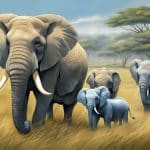Types Of Monkeys
Classifications of the types of monkeys are based on their monophyletic groups, which group the monkeys according to a common ancestor. As far as monophyletic groups go, there are two types, the new world and the old world monkeys. Paradoxically, hybrids or combinations of these two monophyletic groups are not considered monkeys. We can say that humans and apes have been derived from matings between new world and old world monkeys. Apes, humans and monkeys belong to the infraorder Simiiformes, which has led to the classification of monkeys as non-hominoid members of this infraorder.
The most common way to differentiate the different types of monkeys is by using morphology traits that delineate the common ancestor or group of ancestors where these monkeys came from. The range of sizes of the different types of monkeys varies from 4.6 inches (the pygmy marmoset) to almost 4 feet tall (male mandrill). The diet of the different types of monkeys cannot be used as a good tool for classifying them, as they are similar in diet and behavior no matter where they live. Some monkey species live in trees and feed on fruits and small insects living in the same space. Others prefer to stay close to water boddies, like those on savannas. Monkeys also eat eggs, nuts, flowers, leaves and bugs.
Tail characteristics can also be used as a way to classify and differentiate the types of monkeys. Most of the new world monkey species have prehensile tails, which is a good trait that differentiates them form old world monkeys, which have non-prehensile tails or don’t show this appendage at all. Siilar to humans, most old world monkey types have trichromatic color vision. New world monkeys, however, have monochromatic visions like the owl monkeys. Other types of new world monkeys have trichromatic and dichromatic vision.
While many of the types of monkeys in the world today are still feral, in that they live in the wild, even in suburban areas and are wary of people, some monkey species have been domesticated that even feral counterparts have an affinity of some sort to humans. The most domesticated kind of monkey species are those that have been born in a human home, so that they associate themselves with their adopted families and share the same behavioral traits like not wanting a certain type of food that the family avoids eating. Some monkeys are intelligent and well-trained, and are put on the job for many of the specific works that need smaller hominoids, for instance, space travel in a cramped space ship. The many species of monkey have varied relationships with humans. Some are kept as pets, others
Feral monkey species are often considered pests of fields and other agricultural facilities. These feral monkeys come in large troops and can threaten acres of farmland when not contained. Many debates have sprung from the issue of whether to kill these monkeys or deal with them in such a way that their existence are not threatened. All the different types of monkeys are highly trainable, and are often used as service animals, companions for the disabled, and companions for farmers. Some monkeys are used in shows meant for tourists.






